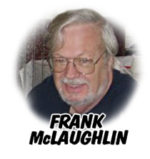 Frank McLaughlin married Carol Pierce in 1965, and he and his wife have two sons. His niece, Anne McLaughlin, is also a professional artist. In 1962, Frank McLaughlin’s professional comic book career began, starting with the Charlton Comics’ titles Reptisaurus, and the Pre-Steve Ditko ‘Blue Beetle’ title.
Frank McLaughlin married Carol Pierce in 1965, and he and his wife have two sons. His niece, Anne McLaughlin, is also a professional artist. In 1962, Frank McLaughlin’s professional comic book career began, starting with the Charlton Comics’ titles Reptisaurus, and the Pre-Steve Ditko ‘Blue Beetle’ title.
(Later, Steve Ditko would illustrate at that company a character, also called The Blue Beetle, which was a completely – different comics character, and with a different costume, powers, and origin story.) Other Charlton Comics work Frank McLaughlin did include Son of Vulcan, Strange Suspense Stories, and Mysteries of Unexplored Worlds. At Charlton, McLaughlin created the very well-acclaimed World War Two era superhero Judomaster, which ran eleven exciting issues.
 After leaving Charlton Comics after nearly a decade of top-notch Frank McLaughlin – illustrated stories, there, Frank’s first DC Comics work appeared, in The Flash # 215.
After leaving Charlton Comics after nearly a decade of top-notch Frank McLaughlin – illustrated stories, there, Frank’s first DC Comics work appeared, in The Flash # 215.
Also in the 1970s, while Mr. McLaughlin was in a freelancing period, he worked on various issues of Wonder Woman, Detective Comics, Green Lantern, Green Arrow, and others, at DC Comics.
And at Marvel, McLaughlin worked on various issues of Captain America, the Kree-born Captain Marvel, and The Defenders. Mr. McLaughlin in the 1970’s additionally inked (with Dick Dillin pencils) a lavishly illustrated, lengthy and impressive run on The Justice League of America, for several years.
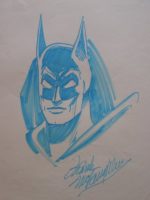 Just some of the other major titles Frank McLaughlin worked on at DC, included Batman, Superman, Action Comics, and The Red Tornado limited series.
Just some of the other major titles Frank McLaughlin worked on at DC, included Batman, Superman, Action Comics, and The Red Tornado limited series.
Following the 1970’s, Mr. McLaughlin worked on many syndicated newspaper comic strip series, including Stan Drake’s ‘The Heart of Juliet Jones’, Bushmiller’s ‘Nancy’ strip, Dale Messick’s ‘Brenda Starr’, and from 2001 through 2008, McLaughlin illustrated Jack Berrill’s ‘Gil Thorp’, which is a sports-based newspaper daily newspaper comic strip. The ‘Gil Thorp’ writers were Jerry Jenkins and Neal Rubin, for The Tribune Media Services.
During the 1990s, Mr. McLaughlin did work for Acclaim Comics, and Broadway Comics.
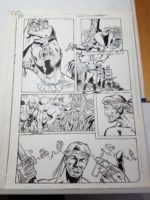 Below: ‘Gil Thorp’, 2001, with Frank McLaughlin art.
Below: ‘Gil Thorp’, 2001, with Frank McLaughlin art.
First Comics News: Mr. McLaughlin, I started following your comic book career, in that industry, as a five-year-old, in 1965, commencing with your early Charlton Comics’ Judomaster series. I still have all eleven issues, including Judomaster’s Silver Age First – ever appearance, in ‘Special War Series’ # 4, plus Judomaster’s ten-issue run in is own self-titled Silver Age series, plus his appearances in the ‘Sarge Steel’ title, the title name of which later changed to ‘Secret Agent.’
Note: Judomaster also appeared in a 3-page feature in Peter (‘P.A.M.’) Morsi’s Peter Cannon/-Thunderbolt # 52, in 1966.
What a shame that these Judomaster issues that you illustrated back then, have never (as yet) come out in a collected edition-!
Frank McLaughlin: As an aside….since the recent overwhelming fan interest in Charlton (Comics) art, especially Judomaster, I am proud to say, I am deluged with requests for paid commissions.
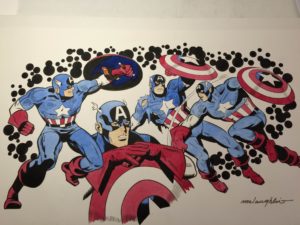 1st: Mr. McLaughlin, do you recall how old you were, when you first picked up a pencil, with the aim of teaching yourself to draw, at that time? I’ve been reading several impressive articles about your life and career in comics and other vocations, online, including the Wikipedia entries on yourself, and the Wikipedia entry on Judomaster: your self-created character – (with Joe Gill.)
1st: Mr. McLaughlin, do you recall how old you were, when you first picked up a pencil, with the aim of teaching yourself to draw, at that time? I’ve been reading several impressive articles about your life and career in comics and other vocations, online, including the Wikipedia entries on yourself, and the Wikipedia entry on Judomaster: your self-created character – (with Joe Gill.)
Frank McLaughlin: Phil… just to clear up something…I alone created Judomaster. I had been a judo player at age 18, not 8. I had kicked around the idea with Charlie (John Santangelo’s son), who also was a judoka. And one time, when John Santangelo was in Europe, he decided to put it (the Judomaster comics title) on the production schedule, replacing ‘Gunmaster’, with ‘Judomaster.’ Since Joe Gill was also the comics editor, as well as the only writer, he approved the script and suggested a few minor changes. John Santangelo never noticed the change (between the western Gunmaster series, and the World War Two superhero Judomaster series that replaced it) when he returned, and he never mentioned it, as far as I knew.
Maybe he noticed it when it topped off sales, and he thought better of it.
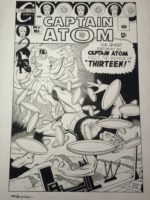 Frank McLaughlin: I was about 6 or 7 when I first began to draw comics, that I saw in the Sunday papers. As a youngster of 4 or 5, my brother Jim and I would lie on the floor, and draw from the Sunday newspaper color comics. There was no T.V., and at that age, movies were out of the question. It was the only form of entertainment available. A few years later, we decided to draw our own comic strip [it looked so easy.] I was only eleven or so, and Jim was nine. And after school, we walked into the offices of the local weekly newspaper and showed our drawings to the lone person in the tiny office. He thought it was a great idea to publish the strip. We quickly became Holy Trinity School’s overnight rock stars! This business of drawing comics was so easy! Little did we know….
Frank McLaughlin: I was about 6 or 7 when I first began to draw comics, that I saw in the Sunday papers. As a youngster of 4 or 5, my brother Jim and I would lie on the floor, and draw from the Sunday newspaper color comics. There was no T.V., and at that age, movies were out of the question. It was the only form of entertainment available. A few years later, we decided to draw our own comic strip [it looked so easy.] I was only eleven or so, and Jim was nine. And after school, we walked into the offices of the local weekly newspaper and showed our drawings to the lone person in the tiny office. He thought it was a great idea to publish the strip. We quickly became Holy Trinity School’s overnight rock stars! This business of drawing comics was so easy! Little did we know….
1st: Do you happen to recall the name of the college friend who first introduced you to – or referred you to Charlton Comics’ Pat Massulli, in Derby, Connecticut, in the early 1960s? I’m wondering what you may recall of those events?
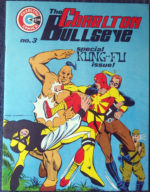 Frank McLaughlin: Phil… all through my career, I have been blessed with the greatest of friends, beginning with a classmate at art school; Larry Conti. Larry hooked me up with his brother, Dan Conti, who was a department head at Charlton Press (publisher of Charlton Comics, in Derby, Connecticut.) Dan, in turn, introduced me to Charlton’s Pat Masulli, editor in chief of comics. Timing was perfect, because his assistant, Sal Gentile, was about to leave for Florida, in two weeks. I was hired on the spot, and Sal gave me an immediate ‘cook’s tour’ of the plant. It took me a few days for all this to sink in, but Sal was a terrific guy, and this made it easy for me to understand the job. Dealing with Pat was a different story…
Frank McLaughlin: Phil… all through my career, I have been blessed with the greatest of friends, beginning with a classmate at art school; Larry Conti. Larry hooked me up with his brother, Dan Conti, who was a department head at Charlton Press (publisher of Charlton Comics, in Derby, Connecticut.) Dan, in turn, introduced me to Charlton’s Pat Masulli, editor in chief of comics. Timing was perfect, because his assistant, Sal Gentile, was about to leave for Florida, in two weeks. I was hired on the spot, and Sal gave me an immediate ‘cook’s tour’ of the plant. It took me a few days for all this to sink in, but Sal was a terrific guy, and this made it easy for me to understand the job. Dealing with Pat was a different story…
Later on, Charlie Santangelo took over the business, and Pat Masulli was on the way out. Charlie offered me the job, and I asked for a day to get back to him. It was then that I asked Dick (Giordano) if he was interested (in that position), and he said yes. Charlie agreed, so I could free up time to work on Judomaster. Dick and I swapped jobs, as I went to his studio, and he took over at Charlton. We met for lunch at the studio every day and matched notes. Things were getting hectic…at one point, we were working for five comic publishers at once! Plus, plenty of work from Charlton. It was around that time that I met my best friend and future wife-to-be, Carole Pierce, Pat’s former secretary!
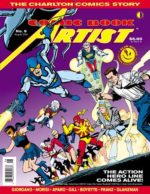 1st: How young would you have been, then?
1st: How young would you have been, then?
Frank McLaughlin: I was 29.
1st: From numerous things (all positive, of course) that I read about you online, and also from things that I knew about you well prior to that, because I’ve sincerely followed your work in comics, for literally decades….it certainly sounds as though you were quite an athlete, throughout the course of your lifetime! Let’s see: you took martial arts from age 18 through 50, and you were an avid baseball player. When you went to work for the vehicle brakes manufacturer Raybestos, you also played for its’ internationally-ranked fast pitch baseball team! As a baseball fan, I’ve just got to ask: how fast was your fastball? Also, Mr. McLaughlin, do you recall the name of the Raybestos Baseball team?
Frank McLaughlin: I was a baseball pitcher in college, and later on I played as an outfielder for the Raybestos Cardinals, a fast pitch softball team; not baseball.
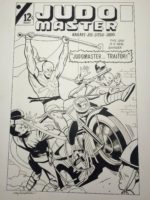 1st: Did you then, and do you now, as a fan of baseball, have a favorite baseball team? And has baseball been a lifetime interest? Something you possibly might wish to actively seek out, as a fan of professional baseball, is the multi-part ‘The History of Baseball’ documentary, by Ken Burns, which is fantastic, and which plays every so often, on channel PBS. I wouldn’t be surprised if it is available for borrowing at one of your local libraries. It is, in my area.
1st: Did you then, and do you now, as a fan of baseball, have a favorite baseball team? And has baseball been a lifetime interest? Something you possibly might wish to actively seek out, as a fan of professional baseball, is the multi-part ‘The History of Baseball’ documentary, by Ken Burns, which is fantastic, and which plays every so often, on channel PBS. I wouldn’t be surprised if it is available for borrowing at one of your local libraries. It is, in my area.
Frank McLaughlin: We are talking 50 years ago. I did plenty of ‘commercial art’ jobs, and I still do. Comics are a lot more fun. As far as writing and drawing Judomaster, I think we covered that, for the most part. Joe Gill’s name appearing as the writer, (on Judomaster), was to satisfy John Santangelo’s arrangement with Joe. I wrote all of those, myself. Judomaster’s first appearance (Note: in Charlton Comics’ ‘Special War Series’ # 4), came about while John Santangelo was in Italy, and Charlie was left in charge. My military experience had not been an influence on my scripts. I’ve been a big baseball fan since age 5. I played in high school and college, and when I worked at Raybestos, I played fast pitch softball, and I played the outfield, there. I was a pitcher in baseball, and I am a lifelong Red Sox fan. I have no idea what the Japanese lettering on the Judomaster’s masthead covers mean.
 *** Note: my older brother, James (and I), have had a Toronto friend named Cynthia, for thirty-eight YEARS! Cynthia, originally, from the Philippines, Cynthia has a very, very intelligent daughter, named Sasha, who speaks and writes multiple languages, including Japanese; despite the fact she is only 18 (eighteen) years old! Cynthia herself is a computer programmer. Several months after this particular article went to press, I asked Cynthia to ask Sasha to translate the two Japanese symbols that adorn the Silver Age (1960’s) Charlton ‘Judomaster’ comic book covers, from # 96 through # 98, the final issue of the series.
*** Note: my older brother, James (and I), have had a Toronto friend named Cynthia, for thirty-eight YEARS! Cynthia, originally, from the Philippines, Cynthia has a very, very intelligent daughter, named Sasha, who speaks and writes multiple languages, including Japanese; despite the fact she is only 18 (eighteen) years old! Cynthia herself is a computer programmer. Several months after this particular article went to press, I asked Cynthia to ask Sasha to translate the two Japanese symbols that adorn the Silver Age (1960’s) Charlton ‘Judomaster’ comic book covers, from # 96 through # 98, the final issue of the series.
Sasha looked at them, and immediately told her mother, that these two Japanese symbols, together, form the single word, ‘JUDO.’ And so, this mystery, which I have wondered about, off and on, my entire life – is now SOLVED!
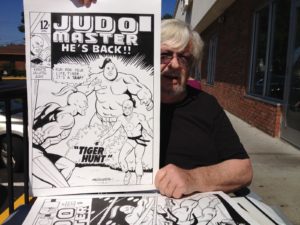 1st: I understand that, after college, and after a year working at Raybestos, where you were also, (as above), on the Raybestos Cardinals fastpitch softball team, that you were drafted into the U.S. Army, for a time. I’m curious: since you were drafted, was the U.S. at war, then? I’m a student of history, and history has been a life-long interest of mine. Since I don’t know how old you were when you were drafted, nor what year that was, can you kindly tell us what conflict or war was taking place at that time, that saw you drafted? How long were you in the U.S. Army, and what can you tell our readers about that?
1st: I understand that, after college, and after a year working at Raybestos, where you were also, (as above), on the Raybestos Cardinals fastpitch softball team, that you were drafted into the U.S. Army, for a time. I’m curious: since you were drafted, was the U.S. at war, then? I’m a student of history, and history has been a life-long interest of mine. Since I don’t know how old you were when you were drafted, nor what year that was, can you kindly tell us what conflict or war was taking place at that time, that saw you drafted? How long were you in the U.S. Army, and what can you tell our readers about that?
Frank McLaughlin: I enlisted in the army as part of the RFA program, and I served 6 months of active duty, and 5 years as a Reservist. This was Post Korea war and Pre Viet Nam war. I never left stateside.
1st: When you left the U.S. Army, I understand that you became a Technical Illustrator at Sikorsky Aircraft. Do you also hold an Engineering degree?
Frank McLaughlin: No engineering degree.
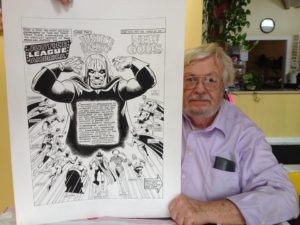 1st: By 1962, you had become Charlton’s Art Director. I’ve read about a half dozen interesting and entertaining stories about Charlton’s head writer, Joe Gill – including, in the quarterly publication The Charlton Spotlight magazine, and from other sources, as well. I understand that Joe Gill wrote (most) everything for the Charlton Comics company. Can I get your recollections and remembrances about him, at Charlton?
1st: By 1962, you had become Charlton’s Art Director. I’ve read about a half dozen interesting and entertaining stories about Charlton’s head writer, Joe Gill – including, in the quarterly publication The Charlton Spotlight magazine, and from other sources, as well. I understand that Joe Gill wrote (most) everything for the Charlton Comics company. Can I get your recollections and remembrances about him, at Charlton?
Frank McLaughlin: My drawing board was right next to Joe Gill’s desk, and we hit it off… right away. Both he and I were radio operators in the military; he in World War Two, and me, much later on. He had the amazing ability to type comic scripts and carry on a conversation at the same time. He was probably the most productive comic scriptwriter of all time; often over 100 pages a week! He also taught me how to blow my dough, betting at Jai Alai. Joe had a special and unique position at Charlton. Joe was not only the only writer, but he also was his only editor. No one on staff was allowed to do freelance work per order, from the owner, John Santangelo. That is, no one, except Joe. He would submit scripts under fictitious names, usually gleaned from labels of booze bottles, with his own ironic twist. Jim Beam became author James Beam, etc.
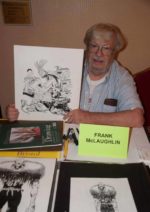 Joe played cards with John Santangelo every day at lunch, and, ‘rolled over’, and let him win, every so often. Joe was probably the closest thing to a friend John ever had. Friday night turned out to be poker night, on a regular basis. Bill and Angie Anderson hosted all of us at their home on Atwater Avenue, a block away from Charlton. (In Derby, Connecticut.) The usual cast of high rollers included Bill Anderson, Joe Gill, (Captain Atom’s) Rocke Mastroserio, Dick Giordano, Pat Bastienne, Dave Glanzman, myself, and cameo appearances by other Charlton folks. It was great fun, and Patty usually turned out to be the big winner. Dick (Giordano) was always a tough-luck loser. There were nights when he would have a great hand, and lose to someone with a better one – usually Patty. He just couldn’t get arrested!
Joe played cards with John Santangelo every day at lunch, and, ‘rolled over’, and let him win, every so often. Joe was probably the closest thing to a friend John ever had. Friday night turned out to be poker night, on a regular basis. Bill and Angie Anderson hosted all of us at their home on Atwater Avenue, a block away from Charlton. (In Derby, Connecticut.) The usual cast of high rollers included Bill Anderson, Joe Gill, (Captain Atom’s) Rocke Mastroserio, Dick Giordano, Pat Bastienne, Dave Glanzman, myself, and cameo appearances by other Charlton folks. It was great fun, and Patty usually turned out to be the big winner. Dick (Giordano) was always a tough-luck loser. There were nights when he would have a great hand, and lose to someone with a better one – usually Patty. He just couldn’t get arrested!
 1st: Charlton’s Judomaster, of course, was a World War Two costumed superhero type who was extremely unique, in that he operated in the Japanese Theatre of Operations, in defense of Japanese Civilians against their aggressors; ironically, their own people, The Japanese Imperial Army. Another interesting irony was that Judomaster, dressed in a Japanese ‘Land of The Rising Sun’ nation’s Flag-inspired costume, was actually a Caucasian U.S. Army Sergeant, named Rip Jagger! Judomaster lasted eleven fantastic issues from Charlton Comics, published – if memory serves – around 1965 forward, including J.M’s first appearance, in the fourth (and final) Silver Age issue of the Charlton anthology war title, ‘Special War Series.’ The Judomaster comics series was always, far and away, my own # 1 favorite of all of the Charlton ‘Action (super) Heroes.’ So much so, that, when I was in my twenties, I created my OWN pen and ink illustrations of Judomaster, versus at least one of his enemies, ‘The Cat‘, on illustration board, in the mid-1980s. You see, this character, Judomaster, really spoke to me, for some reason! I also felt that your creation, Judomaster, had one of the very best Silver Age superhero costumes, of all! And that is really saying a lot from me, since the other contenders, also published by Charlton Comics, at the same time – including Steve Ditko’s Captain Atom and Blue Beetle, (not to mention the pre-Ditko Blue Beetle, who was a completely different character, by other writers and artists); Pat Boyette’s The Peacemaker, Pete Morisi’s ‘Peter Cannon/- Thunderbolt’, Sarge Steel/- Secret Agent, Son of Vulcan, and The Fightin’ Five.
1st: Charlton’s Judomaster, of course, was a World War Two costumed superhero type who was extremely unique, in that he operated in the Japanese Theatre of Operations, in defense of Japanese Civilians against their aggressors; ironically, their own people, The Japanese Imperial Army. Another interesting irony was that Judomaster, dressed in a Japanese ‘Land of The Rising Sun’ nation’s Flag-inspired costume, was actually a Caucasian U.S. Army Sergeant, named Rip Jagger! Judomaster lasted eleven fantastic issues from Charlton Comics, published – if memory serves – around 1965 forward, including J.M’s first appearance, in the fourth (and final) Silver Age issue of the Charlton anthology war title, ‘Special War Series.’ The Judomaster comics series was always, far and away, my own # 1 favorite of all of the Charlton ‘Action (super) Heroes.’ So much so, that, when I was in my twenties, I created my OWN pen and ink illustrations of Judomaster, versus at least one of his enemies, ‘The Cat‘, on illustration board, in the mid-1980s. You see, this character, Judomaster, really spoke to me, for some reason! I also felt that your creation, Judomaster, had one of the very best Silver Age superhero costumes, of all! And that is really saying a lot from me, since the other contenders, also published by Charlton Comics, at the same time – including Steve Ditko’s Captain Atom and Blue Beetle, (not to mention the pre-Ditko Blue Beetle, who was a completely different character, by other writers and artists); Pat Boyette’s The Peacemaker, Pete Morisi’s ‘Peter Cannon/- Thunderbolt’, Sarge Steel/- Secret Agent, Son of Vulcan, and The Fightin’ Five.
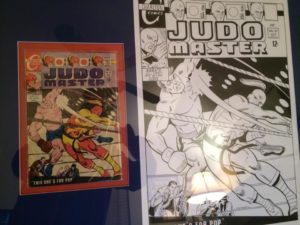
After Judomaster’s first appearance in ‘Special War Series # 4 (the final issue of that title), he next appeared in Sarge Steel # 6, dated December of 1965 issue, before graduating to his own title. I’d say that, in my considered opinion, Judomaster was, to me, the most interesting and exciting series of all of those, to read! That is, of course, just my own personal opinion, and that it goes without saying that ALL of these above-named characters were extremely popular, at the time – and since. They all – among older readers such as myself -still have a very large ‘cult’ following, to this day! Back in the 1980s, I even went so far as to customize ‘DC Super Powers’ commercial action figures, into Judomaster, his partner Tiger, Captain Atom, Blue Beetle (the Ditko version), Peacemaker, and Peter Cannon/-Thunderbolt. I still have the two Judomaster – themed art pieces I did, in the 1980’s, as well as those one of a kind each, above mentioned custom Charlton action figures. I’ll include photos of these with the interview as well, just for fun. I wasn’t the only fan who did custom action figures based on some of the Charlton Silver Age Action heroes. I’ve found photos of some of those on the net, as well. I think JM was certainly the most unique concept of them all! I understand that, despite the fact that some of those Judomaster comics scripts of the Silver Age say that Joe Gill wrote some, you mentioned you wrote them all, and that the fact some of them were credited to Joe Gill, due to an arrangement with John Santangelo. When the truth of the matter is, that you wrote them all. I’d always wondered about that, and I’m glad we were able to clear that up. Were your synopses and storylines for the Judomaster comics series inspired, somewhat, by your time in the U.S. Army?
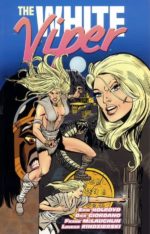 Frank McLaughlin: The Judomaster stories were not inspired by my time in the Army.
Frank McLaughlin: The Judomaster stories were not inspired by my time in the Army.
1st: Your Silver Age Judomaster comics series was fantastic, in every possible way! Joe Gill, who I understand created the Judomaster character, (writing-wise), created the character with YOU in mind for the artist of that series, specifically, since you were already, even then, were-versed and well-involved with Judo (including, I’m guessing, Judo tournaments.) Or, was it just a coincidence that this art assignment got handed to you, from him? Or, did YOU, writing-wise, come up with the character of Judomaster yourself, and then, you handed the idea to Joe Gill to write the earliest scripts of that series, and for you to illustrate it?
Frank McLaughlin: That’s a misconception. I alone created Judomaster, and I alone wrote all the scripts for that series. Don’t believe everything you read online.
1st: For all of my life (and I was about age five, when Charlton’s Judomaster first materialized from Charlton Comics – so you can do the math yourself, Sir) ~ I’ve always considered the costumed Judomaster to have one of the very best – designed superhero costumes of The Entire Silver Age of Comics! I’m not kidding. Was it, I suspect, totally your design?
Frank McLaughlin: Yes.
 1st: I do recall that, in some of the Silver Age 1960’s Judomaster letters pages, a few readers took issues with Judomaster’s ‘top knot’ braid on top of his crimson mask – which, in his first appearance, in ‘Special War Series’ # 4 (the final issue of that title), was Rip Jagger’s own hair, poking through the top of his facial disguise. Did you or anyone else at Charlton Comics ever figure out what the Chinese letters at the top of each Judomastercover masthead spelled out or read? I recall this question being asked in one of the original Judomaster letters pages, way back when. And, at the time, everyone on the Charlton editorial staff was all equally mystified by that! Any idea? I’m sort of hoping that the English translation didn’t turn out to be “Please put the seat in the ‘down’ position, before flushing.” Smile. Just kidding!
1st: I do recall that, in some of the Silver Age 1960’s Judomaster letters pages, a few readers took issues with Judomaster’s ‘top knot’ braid on top of his crimson mask – which, in his first appearance, in ‘Special War Series’ # 4 (the final issue of that title), was Rip Jagger’s own hair, poking through the top of his facial disguise. Did you or anyone else at Charlton Comics ever figure out what the Chinese letters at the top of each Judomastercover masthead spelled out or read? I recall this question being asked in one of the original Judomaster letters pages, way back when. And, at the time, everyone on the Charlton editorial staff was all equally mystified by that! Any idea? I’m sort of hoping that the English translation didn’t turn out to be “Please put the seat in the ‘down’ position, before flushing.” Smile. Just kidding!
Frank McLaughlin: No idea.
Note: this was cleared up, earlier in this interview. Those two Japanese symbols, taken together, translate as the word ‘JUDO.’
 1st: It’s pretty well – known among vintage Charlton Comics collectors (including myself), that, after Judomaster’s first appearance in ‘Special War Series’ # 4, the second issue of J.M, after he first/-next appeared in Sarge Steel # 6, was in Judomaster’s own title, the first issue of which was numbered # 89, the numbering has been continuing from the then recently defunct, long-running Gunmaster title.
1st: It’s pretty well – known among vintage Charlton Comics collectors (including myself), that, after Judomaster’s first appearance in ‘Special War Series’ # 4, the second issue of J.M, after he first/-next appeared in Sarge Steel # 6, was in Judomaster’s own title, the first issue of which was numbered # 89, the numbering has been continuing from the then recently defunct, long-running Gunmaster title.
Which, despite the similarity of names, the characters were in no way related, since Gunmaster (the character of which started in the title ‘Six Gun Heroes’, was set in the 1880’s Old West. Of course, since there also exists a Gunmaster # 89, as well as a Judomaster # 89, the first issue of Judomaster should actually have been numbered # 90.
Oops! Did you do any work on Gunmaster?
Frank McLaughlin: No.
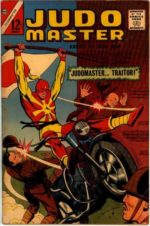 1st: In recent decades, some interesting unpublished-by-Charlton Comics items have turned up: an (unpublished Steve Ditko version) of the Silver Age Blue Beetle # 6 completely illustrated comics issue, as well as a completely illustrated The Peacemaker # 6, by Pat Boyette. And even an unpublished Ditko Captain Atom # 90, the inking of which was completed, much, much later, by John Byrne.
1st: In recent decades, some interesting unpublished-by-Charlton Comics items have turned up: an (unpublished Steve Ditko version) of the Silver Age Blue Beetle # 6 completely illustrated comics issue, as well as a completely illustrated The Peacemaker # 6, by Pat Boyette. And even an unpublished Ditko Captain Atom # 90, the inking of which was completed, much, much later, by John Byrne.
The Blue Beetle # 6, by Steve Ditko, was published only in an issue of the fanzine CPL (‘Contemporary Pictorial Literature’), many decades back. While the Silver Age Captain Atom # 90 saw print ONLY, spread over two issues of the magazine-sized ‘The Charlton Bullseye’ fanzine # 1 and # 2. Finally, Pat Boyette’s The Peacemaker # 6 has never been published in any form — though I have photocopies of the entire issue that I printed off of the internet, many years back. My question is, do you recall having ever, back in the 1960s, having illustrated or at least penciled any art pages for the never published Judomaster # 99-? And if so, do you still have any of those pages, or recall anything about it?
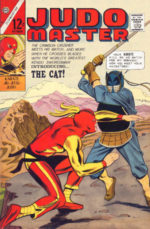 Frank McLaughlin: Phil… as you may know, Charlton routinely destroyed all original art except for a few pages that were stolen. The only ‘Charlton’ original art I have was work done for DC’s proposed weekly comic book ‘Blockbuster‘, which was scrapped almost immediately. I may have a few pages of that, in various stages of development.
Frank McLaughlin: Phil… as you may know, Charlton routinely destroyed all original art except for a few pages that were stolen. The only ‘Charlton’ original art I have was work done for DC’s proposed weekly comic book ‘Blockbuster‘, which was scrapped almost immediately. I may have a few pages of that, in various stages of development.
1st: NOTE: Mr. McLaughlin did, in fact, locate for us later, several original, and never published, new at the time Judomaster pages for the never published DC Comics’ title, ‘Blockbuster’, which are published, right here with this interview, for the very first time, anywhere-!!!
Frank McLaughlin: Yippee!!! I found the missing Blockbuster pages! Since I have hundreds of pages stored here, it took a bit of time to locate them. I’ll have them photographed, and send them along to you.
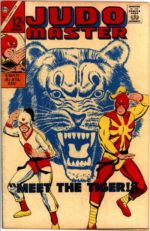 I hope you can see the pencils on the unfinished pages. More pages to come. No prejudice on the part of DC Comics. I don’t think these stories were sub-par. They were written in installments of only five pages per week. The idea of a weekly comic was probably a bad idea, to begin with. I don’t think an editor in his right mind would look forward to editing such a project. Too many things can go wrong. There are no shots of Judomaster in costume (in the D.C. unpublished Blockbuster original Frank McLaughlin comics pages), for the comics mini-series, since I didn’t get that far into the script. All the pages I sent you, are all I have. More to come soon.
I hope you can see the pencils on the unfinished pages. More pages to come. No prejudice on the part of DC Comics. I don’t think these stories were sub-par. They were written in installments of only five pages per week. The idea of a weekly comic was probably a bad idea, to begin with. I don’t think an editor in his right mind would look forward to editing such a project. Too many things can go wrong. There are no shots of Judomaster in costume (in the D.C. unpublished Blockbuster original Frank McLaughlin comics pages), for the comics mini-series, since I didn’t get that far into the script. All the pages I sent you, are all I have. More to come soon.
1st: Here is a question that numerous Charlton Comics fans have wondered about, since the 1960s: do you happen to know WHY Charlton got out of the superhero comics business after the 1960’s run of Steve Ditko’s Blue Beetle and Captain Atom, Pat Boyette’s The Peacemaker, Pete A. (‘P.A.M’) Morsi’s Peter Cannon/- Thunderbolt, and Dick Giordano’s Sarge Steel/-Secret Agent-?
Frank McLaughlin: No idea.
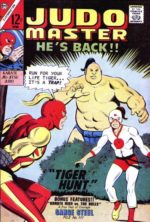 1st: Frank, The Fightin’ Five was another favorite of mine. On another topic, what can you tell us about the personalities and/or work habits of any of the other Charlton staff? For example, did you get to know Steve Ditko, Dick Giordano, George Wildman, Pat Boyette, or any of the other writers and artists, etc., very well?
1st: Frank, The Fightin’ Five was another favorite of mine. On another topic, what can you tell us about the personalities and/or work habits of any of the other Charlton staff? For example, did you get to know Steve Ditko, Dick Giordano, George Wildman, Pat Boyette, or any of the other writers and artists, etc., very well?
1st: Did you do any work on the long-running Charlton title ‘The Fightin’ Five’? That was another favorite of mine.
Frank McLaughlin: Regarding The Fightin five. Never worked on it.
1st: You and Dick Dillin had an extremely long, very impressive run on DC Comics’ Justice League of America, where you did a fantastic, consistent job, inking his pencils. Do you recall how you landed that assignment? And what, if anything, can you tell us about Dick Dillin?
Frank McLaughlin: Notes on Dick Dillin….. Dick was a very hard worker. Fans rarely mention his name, but, boy, they sure bought his work! I never understood that.
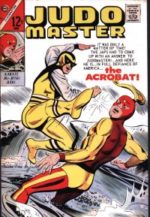 1st: Nor I, Frank. Dill Dillin’s and your own combined work on the 1970s and up Justice League of America series – and you jointly worked on that series for several years, together….his was a High Water Mark, in comics! The sheer craftsmanship was altogether excellent, and I particularly enjoyed seeing both of you bring back to comics, numerous previously-forgotten about Golden Age 1940’s comics characters, including many from Fawcett Comics. For example, Sargon the Sorcerer, Spy Smasher, Mr. Scarlet and Pinky, and so many others!!
1st: Nor I, Frank. Dill Dillin’s and your own combined work on the 1970s and up Justice League of America series – and you jointly worked on that series for several years, together….his was a High Water Mark, in comics! The sheer craftsmanship was altogether excellent, and I particularly enjoyed seeing both of you bring back to comics, numerous previously-forgotten about Golden Age 1940’s comics characters, including many from Fawcett Comics. For example, Sargon the Sorcerer, Spy Smasher, Mr. Scarlet and Pinky, and so many others!!
Frank McLaughlin: Justice League of America was always at the top, in sales. Our work was part of a large exhibit recently, at The Society of Illustrators Gallery in N.Y.C., where I had the chance to meet members of Dick Dillin’s wonderful family and friends. Dick Giordano and I were working on other publishers’ books, while still at Charlton Comics. Justice League of America was one of those books. There were others, as well. Oddly enough, I never met Dick Dillin. We spoke often, by phone, but we never crossed paths at the DC Offices. I missed him by a few minutes, at times, but we both used messengers to pick up and deliver. I did meet his whole family and friends, during our showing of a hundred or so pages of (the 1970’s) of Justice League of America art, at The Society of Illustrators, in N.Y.C. I mentioned this, in previous messages to you. Obviously, Judomaster was my fave!
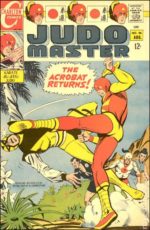 1st: Mine too, Frank!
1st: Mine too, Frank!
Frank McLaughlin: Eastern Color was also a newspaper in Waterbury, Connecticut, called The Waterbury Republican. I produced art for their ads; also commercial comics for Radio Shack, through them. We are all quickly moving toward a paperless society. And soon, artwork done on paper [comics art] will become quite valuable, in my humble opinion. Just check out sales of original comic art prices, to high-end collectors. I did a few ‘how to draw’ books for Renaissance Books. I’m presently working on a proposal for a comics-related T.V. show. Looking for a producer.
1st: On the ‘Charlton Arrow’ website, which is basically a Rebirth of sorts of Charlton Comics, CHARLTON NEO COMICS. I’ve seen several Charlton war titles that, while uncredited, look very much like your particular art style, on them. Am I correct that you produced a number of Charlton war comics stories? And if so, do you recall on which titles? Did you do any westerns?
Frank McLaughlin: No western comics, and a couple of ‘Fightin’ Army’.
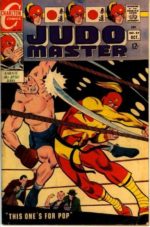 1st: What is this I hear about a Charlton Comics movie? My limited understanding of that is that it is a film documentary on the history of Charlton Comics and its’ creators, including yourself. I also understand that they’ve already filmed you answering questions about that. It sounds like a very interesting and exciting film project! What can you tell us about that? Can you tell us how and when this got off the ground, who is funding it when it will be released, and any other details?
1st: What is this I hear about a Charlton Comics movie? My limited understanding of that is that it is a film documentary on the history of Charlton Comics and its’ creators, including yourself. I also understand that they’ve already filmed you answering questions about that. It sounds like a very interesting and exciting film project! What can you tell us about that? Can you tell us how and when this got off the ground, who is funding it when it will be released, and any other details?
Frank McLaughlin: Check out THE CHARLTON MOVIE; Jackie Zbuska seems to be the producer. I had seen a cartoon poster of it, but not much else.
1st: By chance, do you recall any of the titles of your freelance Radio Shack comic books? I’m guessing these were giveaways?
Frank McLaughlin: I did a book called THE HISTORY OF ELECTRONICS, and a second one; I forget the other title, for radio shack.
 1st: It looks like I’ve seen your art style on several Charlton Comics’ war comics titles from decades ago. Can you confirm that you did some of those? And if so, do you recall any of the titles? Also, I’m wondering – did you do any westerns?
1st: It looks like I’ve seen your art style on several Charlton Comics’ war comics titles from decades ago. Can you confirm that you did some of those? And if so, do you recall any of the titles? Also, I’m wondering – did you do any westerns?
Frank McLaughlin: No westerns I can recall. I did a few issues of Charlton’s ‘Fightin’ Army.’
1st: Frank, do you recall the titles of the Renaissance Books you did on the topic of ‘How to Draw’?
Frank McLaughlin: Yes. ‘How to Draw Comic Book Monsters’, and ‘How to Draw Those Bodacious Bad Babes of Comics’, for Renaissance Books.
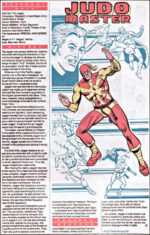 1st: What were the circumstances under your eventually leaving Charlton Comics, and roughly when was that?
1st: What were the circumstances under your eventually leaving Charlton Comics, and roughly when was that?
Frank McLaughlin: Dick (Giordano) and I thought it was time to make the move. Not sure about the date. I think others thought the same, but I don’t think it was a move, as a group.
1st: Frank, I’d like to know, if possible, did you do any work on the Charlton 1960’s western superhero title, ‘Gunmaster‘? The Gunmaster character first appeared in numerous issues of the Charlton title, ‘Six Gun Heroes’, commencing with # 57, then later graduated to his own title. The ‘Gunmaster’ title preceded Judomaster. And secondly, you mentioned that you have a brother named Jim, who, when you were both quite young, you both did artwork for newspaper comic strips. Thus, my second question is, is this your Brother Jim’s work? Check out this link, online, to a ‘Jim McLaughlin, who also did work in the comic book industry. See link! https://www.lambiek.net/artists/m/mclaughlin_jim.htm
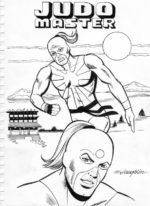 Frank McLaughlin: I never worked on ‘Gunmaster.’ My Judomaster’ followed Gunmaster, as an editorial decision. I don’t know anything about this (other) Jim McLaughlin. My (own) brother Jim paints beautiful landscapes in Florida, where he lives.
Frank McLaughlin: I never worked on ‘Gunmaster.’ My Judomaster’ followed Gunmaster, as an editorial decision. I don’t know anything about this (other) Jim McLaughlin. My (own) brother Jim paints beautiful landscapes in Florida, where he lives.
1st: That’s very cool! My own late mother, whose full name was Sheila Monica Delores Wingfield – Latter, also painted, throughout the last several decades of her life, many beautiful watercolor paintings; hers were sea and landscapes. She was originally from Red Ruth, Cornwall, England. Both of my late parents served in World War Two. My mother was a British Wren, and my father, a Canadian, whose name was Edward Joseph Latter. He was a Canadian Navy torpedo man, and electrician. Will you be possibly doing any more comics work for any of the new NEO-Charlton Comics company titles, that are out now, like for The Charlton Arrow, etc.?
 Frank McLaughlin: As of now, I have no further plans to work in comics. I am working on a few related projects, and I still take paid art commissions.
Frank McLaughlin: As of now, I have no further plans to work in comics. I am working on a few related projects, and I still take paid art commissions.
1st: As mentioned previously in this First Comics News.com interview withFrank McLaughlin, those who wish to procure paid art commissions from Mr. McLaughlin, can reach him by email for this purpose, at Frankart@optonline.net
1st: Frank, do you recall the very last work you did for comic books?
Frank McLaughlin: The last assignment I did was ‘The White Viper’, with Dick Giordano, published. All else I did was published.
1st: Frank, I did some internet (including eBay) research on that product. White Viper was a Creator-Owned graphic Novel, and White Viper was a female hero, published in 2011. I’m interested enough in this project that I intend to procure a copy of it, for myself, from eBay! I’ll be looking forward to reading it! It looks fantastic!
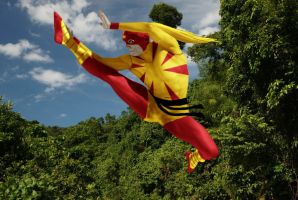 1st: As mentioned previously by myself, fans who wish to inquire to Frank McLaughlin, in terms of asking for paid art commissions from Frank, can reach him by emailing him at Frankart@optonline.net
1st: As mentioned previously by myself, fans who wish to inquire to Frank McLaughlin, in terms of asking for paid art commissions from Frank, can reach him by emailing him at Frankart@optonline.net
Mr. McLaughlin, I wish to take a moment to thank you very, very much, for your numerous kindnesses, in agreeing to this interview, and for providing a great deal of very useful and very insightful information that I have always wondered about, regarding your forty plus years career in comics, for a very long time. You are a true gentleman! Thank you

Having been raised in the U.S. state of Connecticut, comic book and commercial artist Frank McLaughlin was born in Stratford, Connecticut. When he came of age, he enrolled in The University of Bridgeport, as well as at The New Haven State Teacher’s College, both of which were, likewise, located in Connecticut. This was in the 1950s. Mr. McLaughlin taught at The Payer College of Art, in Hamden, Connecticut, as well as at Guy Gilchrist’s Cartoonists Academy, in Simsbury, Connecticut.
